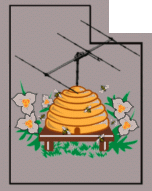 |
Northern
Utah WebSDR
Receiving equipment
An AGC system for RTL-SDR "wideband"
receivers
operating in "Direct" (Q-branch)
mode. |
Figure 1:
An"RTL-SDR.com" USB-based receiver - one of the better,
"cheaper" options out there.
This unit has been programmed and marked with its own, unique (to the system)
serial number.
Click on the image for a larger
version.
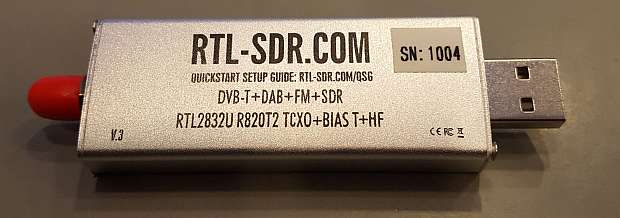 |
A
quick description of RTL-SDR dongles:
The so-called RTL-SDR
dongles are ubiquitous and versatile because they can cover (more
or less)
from a few hundred kHz to over 1.3 GHz using various on-device signal
paths - but all of these signal paths have in common one important
limitation - The A/D converter is only 8 bits.
Despite these
limitations, they are attractive because they are cheap -
from $4 for the "bottom end" and cheapest devices (which are far noisier than they
could be)
to well over $50 for units with frequency converters and a few other bells
and whistles - including band-pass filters. The devices that
we
are using are just $20 and are the RTL-SDR dongles sold by "RTL-SDR
Blog": These units have thoughtfully-designed circuit boards
that
minimize extraneous, spurious responses and include 1ppm TCXOs for
decent frequency stability as well as providing separate signal
branches for "direct" and "quadrature" signal paths for frequency ranges below 30 MHz and above around 60 MHz, respectively.
Ideally, the maximum range represented by an 8 bit A/D converter is
around 48dB - and this is approximately what
can be expected from these devices - but as with most things in the
real world, the actual answer to the question of "what is the dynamic
range" is more complicated. In reality, noise considerations
of
the device reduce the number of usable A/D bits and thus the dynamic
range, this noise coming from the device itself and other devices in
the signal path - but due to what amounts to oversampling and the
contribution of the noise that is always present on HF which can effectively "dither" the A/D converter, the apparent
dynamic range can "seem" to be somewhat greater - perhaps well in the 50dB
range, under some circumstances - but having 50 dB or so of usable dynamic range is not nearly enough for reasonable performance on the HF bands under a wide variety of signal conditions.
|
"But
the Dongle already has an AGC!"
One advantage of using a dongle with an upconverter - a device that
would, say, converter 0-30 MHz to the range of 125-155 MHz -
is that it then places these signals within the range where the R820T
chip can operate - and this chip does
have RF filtering and a sort of AGC - at least by way of being able to have its gain adjusted by software.
Aside from the frequency drift issues related to this frequency
up-conversion mentioned elsewhere, the problem with this is that the
R820T chip really isn't that "strong" in terms of its ability
to handle widely disparate signal
levels. While the RTL2832 chip does have an AGC or sorts, the gain of both
chips in the signal path must be carefully controlled to maximize
performance. Unfortunately, the precise nature of how these all
work together isn't well documented and the general consensus seems to
be that at HF, it doesn't work all that well.
While the built-in AGC can work, we decided to avoid combining the
somewhat
marginal performance of the R820T signal path and the unknown nature of
the AGC operation with the
already-marginal 8 bits of A/D conversion in favor of an external AGC
system operating within the well-defined limits of the dynamics of
these devices when they are operated in "direct" mode.
|
The
problem:
In this specific case, we are using the "Q" branch of the RTL-SDR
dongle for direct
reception of HF signals: For the purposes of this discussion,
we'll limit the frequency range to 30 meters (10.15 MHz)
and lower - a range that encompasses what are, in the current sunspot
cycle, the two most popular HF bands: 40 and 80/75 meters.
Operating
in this range avoids the issues with aliasing mentioned above: Read the page RF Downconverter for RTL-SDR
receivers for a more thorough description of the issues.
In some circumstances and with careful adjustment of RF levels, the
limited dynamic range of the RTL-SDR
dongles is "almost enough" - but because HF conditions widely change
the
"optimal" amount of signal getting into the dongle goes all over the
map: During the daytime on 40 meters, noise can be very low
and there
are very few truly strong signals, but in the evenings or mornings
there can be very strong signals from high-power shortwave broadcast
stations. These disparate situations cause some problems:
- If one adjusts the signal level going into the dongle to
optimize to hear weak signals during the day (e.g. the background noise of
the band driving the A/D converter to 10-15% full scale indication)
it is likely that strong nighttime signals - both amateur and broadcast
- will (more or
less) saturate the A/D converter (e.g. put it into the range of "clipping"),
degrading performance considerably.
- If one adjusts the signal level into the dongle to
accommodate the very strong signals (which is only a "best guess" as
such signals can vary by 10s of dB)
then the input level to the dongle under "quiet" band conditions will
be so low that sensitivity will suffer and spurious signals can appear
everywhere as to few A/D converter bits are being "tickled" and.
As mentioned before, the A/D converter's 8 bits do
provide roughly 50dB of overall signal-handling range, but using one of
these devices on HF soon makes it clear that one must constantly adjust
the input level to assure that that 50dB "window of usefulness" is in
the right place. Using 60 meters as an example again, a
"quiet" band
in a good location may yield around -107dBm of noise in an SSB
bandwidth, but a powerhouse shortwave broadcaster's signal can be into
the -35dBm range - nearly 70dB higher than the noise (and there may be more than one
of these strong signals!)
which represents a range of at least 70dB. What's worse,
taking into
account the need to provide 10-15% of A/D deflection just on the
background noise on a quiet band for the dongles to work properly (to avoid serious issues with quantization-related distortion)
roughly half of the 50dB or so
available to us is already "used"!
Figure 2:
Inside the 4-channel filter and AGC gain block module. The
individual band-pass filters may be seen at the far end of the
lid-mounted PCB ground plane while the actual detection and control
circuitry is on the prototype boards in the foreground near the bottom
of the picture.
Click on the image for a larger
version.
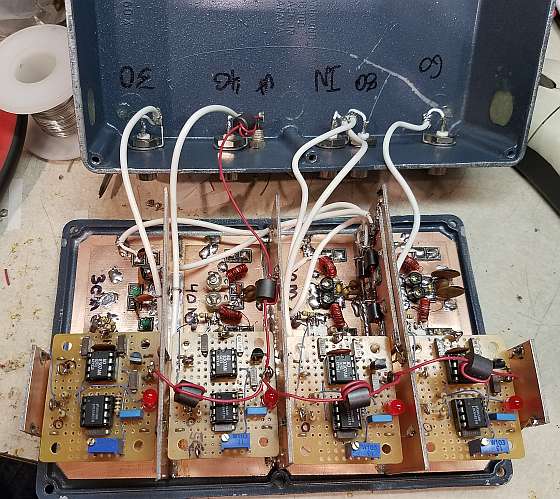 |
Applying
an AGC (Automatic Gain
Control):
Any
RF-based digital direct-sampling (or analog!) receive system - to maintain
optimal performance - must have its input levels constrained, which is to
say that one must take into account both the lowest
and the highest
signal levels. In some cases it is simply enough to
amplify/attenuate the input levels so that the expected
signals will always fall in that range - and this may be practical on
VHF/UHF or microwave, but it is certainly not the case at HF.
Even if
we were to use a higher resolution A/D converter, we would still want
to do this to keep all of the input signals within the "sweet spot":
Direct sampling HF transceivers such as the Icom IC-7300 and
IC-7610
must apply both "strong" band-pass filtering and
input gain control to maximize the performance. In general,
the more
signal we throw into the A/D converter, the better - as long as we
don't overdrive it and cause "clipping".
Such is
the case with the RTL-SDRs: For best performance, one must
have BOTH
"strong" input filtering centered around the frequency range of
interest (the narrower
the better!)
and
keep the signals in the "sweet spot": A properly-designed AGC
can do this.
In short, the signal path and method is like this:
- The signal comes from the antenna.
- Bandpass filtering for the band of frequencies is applied.
The narrower the bandwidth and "sharper" the filtering, the
better.
- On the output of the filter is an electronic attenuator.
- The signal level on the output of the filter (which is being applied to the
dongle) is measured.
- If
the signal level exceeds a set threshold, the amount of attenuation is
increased to cause it to remain at/near that threshold.
In
short, the above system prevents the combination of all signals from
getting to the dongle from consistently exceeding a pre-set level.
In
this way, one can run a bit of "extra" gain to get the best weak-signal
performance, but prevent the system from being hopelessly overloaded
when very strong signals appear.
A
practical implementation:
To maximize performance of the RTL-SDR dongles used for HF reception at
the Northern Utah SDR, a "prototype" module consisting of four bandpass
filters and four AGC gain blocks was constructed - see Figure 2.
Bandpass filters for 90-80 meters, 60-49 meters, 41-40 meters and 31-30
meters were constructed "Manhattan Style" pieces of glass-epoxy circuit
board material as individual filter modules which were then secured to
the main ground plane - a larger piece of PC board material mounted in
the lid of a Hammond 1590D aluminum enclosure. Three dividers
- also made of circuit board material - provide shielding between each
of the band modules.
Constructed on small pieces of phenolic prototype board are the
circuits that detect the RF and derive a control voltage for the
electronic attenuators. These devices are mounted, elevated
above the ground plane and attached to the shield walls which provides
good RF grounding and a DC return path: Two smaller "walls"
are located at the far ends to provide the two boards at the ends with
solid attachment points.
Figure 3:
Schematic of the gain control block.
Click on the image for a larger
version.
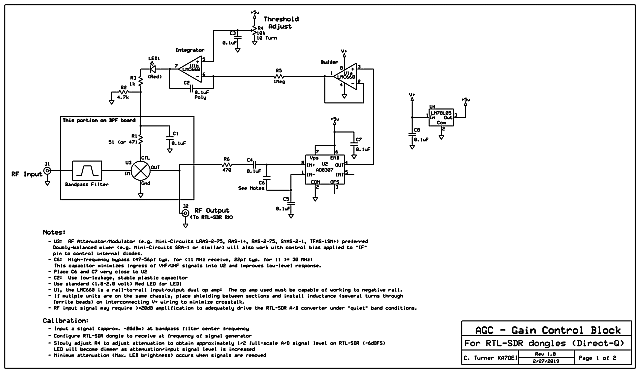 |
Circuit
description:
Figure 3
shows the gain control block schematically.
The input signal passes through the band-pass filter (shown as a block) with
its output connected to a doubly-balanced modulator module, U3.
These devices are nearly identical to standard diode-ring
doubly-balanced mixers, except that they are optimized for operation as
an attenuator or baseband modulator: The attenuation through them
is inversely
proportional to the logarithm of the current applied to the "CTL" (control) port.
In this case I used the Mini-Circuits LRAS-2-75 modules,
originally designed for 75 ohm systems, but they work just fine at 50
ohms as well - being chosen because they are some of the lowest-cost
components of this type offered by Mini-Circuits Labs. The
"official" specifications of the LRAS-2-75 gives specifications down to
just 10 MHz, but it works fine at at least 3 MHz with just an extra dB
or two of insertion loss.
Figure 3 gives a list of other suitable devices - some of which are
rated down to lower frequencies than the LRAS-2-75. Figure 3
also
mentions the use of a standard doubly-balanced mixer such as the
Mini-Circuits SRA-1: A standard mixer will also work acceptably in this
role
if that is what is available. If a standard doubly-balanced
mixer
is used, make sure that it has a port that provides a direct connect to
its internal diodes to which the bias may be applied: While
this
is usually the "IF" port, some devices have this particular port
otherwise designated. The presence of the diodes can be
easily
checked by using the "diode" function of a DVM between the device ground(s) and the
control pin, observing a 0.2-0.3 volt drop in both
directions/polarities of the meter.
The output of the attenuator (U3) goes two places: To the
RTL-SDR
dongle being used for reception, and to the input of U2, an Analog
Devices AD8307 logarithmic amplifier. This device's input
impedance is quite high, so a 470 ohm series resistor (R6) is
used to lightly "tap" the RF coming out of the U3. Included
across the input pins of U2 is a low-value capacitor - typically in the
33-56pF range (as noted
on the diagram)
that is connected very close to the device to quash its response at
VHF/UHF while minimally affecting HF signals: Without this
capacitor, U2 can easily detect any local FM or VHF/UHF TV broadcast
signal and be somewhat "desensed". Practically speaking, this
may
not be a problem - particularly when it is placed inside a shielded
container - but this can be distracting when the circuit is on the
workbench being tested.
The output of U2 is a logarithmic response of the total RF energy
being applied to its input, the voltage increasing by approximately 250
millivolts for every 10dB of increase in signal: If
reasonable
construction techniques are applied, signals well below -70dBm can be
measured. Because the maximum signal level (e.g. A/D converter clipping)
of the "RTL-SDR Blog" dongle is in the range -40dBm, no additional RF
amplification is necessary.
Figure 4:
Two of the gain control modules with U2, the AD8307s being partially
obscured by the ferrite beads. These beads are used to
decouple
any stray RF from the common 12 volt supply line powering the modules.
Click on the image for a larger
version.
 |
U1 must
be an op amp capable of operating down to the negative rail in order
for this circuit to function and the specified LMC660 is ideally
suited. The DC output of U2 is applied to U1a, one half of a
dual op
amplifier, wired as a unity-gain follower which is then applied, via
R5, a 1 Megohm resistor to U1b, which is configured as an integrator by
virtue of a 0.1uF capacitor placed in the feedback path with the
threshold being set by R4, a 10 turn potentiometer. If the
integrated
DC signal from U2 is above this threshold, the voltage output of U1b
decreases, reducing the bias applied to attenuator U3 and increasing
its loss, but if the signal is below the threshold, the voltage
increases, decreasing the attenuation. By this action, the
combination of U1 and U2's action will prevent the average signal at
the RF output from exceeding the threshold level set by R4.
Whereas a
typical AGC found in a receiver will have a fast "attack" and a slow "decay", we want this
AGC to be comparatively slow to respond so that it will (hopefully)
not be completely deafened by the occasional static crash. In
reality,
allowing the A/D converter to hit full-scale on occasional peaks will
have minimal apparent impact on reception. In the absence of
broadband
static crashes, the cumulative power within the bandpass filter's range
will change comparatively slowly over time and it is this that we wish
to track.
In the DC path between the output of U1a and the "CTL"
pin of U3 is a series LED which provides both a bit of logarithmic
current response intrinsic to semiconductor diodes as well as providing
a handy visual indication of the state of the circuit: If the
LED is
lit, attenuation is low, but if it is very dim or turned off, more
attenuation is being applied. In testing, the photosensitivity of LEDs
was simply a "non issue" and ambient light had no discernible effect on
circuit operation. Resistor R3 provides current
limiting to
the diode while R2 provides a current sink: The combination
of R1 and
C1 (located very close
to U3) terminate the "CT" port (at high frequencies)
at the nominal impedance of the RF portion - in this case, around 50
ohms. Also included is U4, a 5 volt regulator: This
supplies power
for U2 as well as provides a stable reference voltage for R4, the RF
threshold adjustment: It need not be exquisitely stable with
temperature as several dB change of the AGC threshold is of no
importance in this application.
Under normal "quiet" conditions the RF level going into U2 will be too
low to exceed the threshold, causing the output of U1b to go to maximum
voltage, biasing U3 to set minimum attenuation - it is only in the
presence of stronger signal(s) that the gain reduction will
occur.
Circuit calibration:
To calibrate the circuit, a signal generator is required, the procedure
being as follows:
- Pre-set the wiper of R4 (the 10 turn pot)
to ground (zero volts
at U1b, pin 5)
- Set a signal generator it
to a frequency within the passband of the filter and an RF level of
around -20dBm.
- Connect the input of the dongle to the signal generator and
tune
it to the frequency of the generator using software. Make
sure
that the "direct - Q" signal path is selected since we are not using an
upconverter.
- If using SDR-Sharp, tuning in the signal (using AM is best)
"hovering" the mouse over it on the waterfall display should give a
dBFS reading.
- If using the "HDSDR" program, the "dBFS" reading will
appear on-screen in the receiver control panel.
- Using the software, monitor the level of the applied RF
signal's "dBFS" (dB
with respect to full-scale).
Ideally, a full-scale A/D indication would yield a dBFS
reading
of around -6dBFS, but it seems that the internal scaling of the signals
from an RTL-SDR dongle aren't scaled, so the reading may be in the -30
to -50 dBFS range. Monitor the "dBFS" from the dongle while
increasing/decreasing the signal and note the highest value.
The
goal here is to determine the reading given by the program.
- Ideally, one would like to be able to see the
"recent-highest"
reading of the A/D converter of the dongle, but this may not be
available in the programs used with the dongle.
- If adventurous, one can use the "librtlsdr" tool called
"rtl_sdr" and dump the results to a file or a display program to
monitor the raw A/D values.
- If you
operate a WebSDR using
the PA3FWM software there is a utility that will directly read out the
number that we want to look at: Contact me directly for
details.
- Having determined the maximum-displayed "dBFS" level,
connect the
signal generator to the input of the bandpass filter and the RTL-SDR
dongle to the output (e.g.
J2 in Figure 3.)
- At this point the LED should not be illuminated and U3 will
offer maximum attenuation.
- Slowly increase R4 until the LED just
starts to be illuminated. Watching the "dBFS" reading adjust
R4
for a signal level that is about 6dB below the maximum reading that
you'd previous obtained. Ideally, one would want to set the
peak
A/D output to between 1/4 and 1/2 of full scale which represents -12 to
-6 dBFS, respectively.
- If the circuit is working properly, any signal above that
corresponding with the threshold should be limited at the set value by
automatically setting U3's attenuation, but a total signal power level
below the threshold should cause U3 to operate at minimum attenuation
as indicated by maximum LED brightness.
Figure 5:
Two bandpass + attenuator (U3)
modules. The inductors/capacitors of the filter may be seen
in the middle of the individual boards while the attenuator (U3) is the white
object seen in the lower-right corner of each board. U3 is
wired "dead bug" style in each case.
Click on the image for a larger
version.
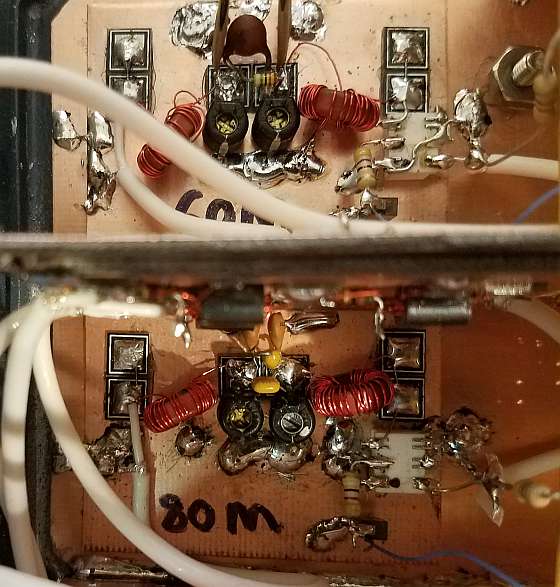 |
Observations in use:
So far, these devices seem to be working as intended. Even with higher overall
gain in the signal path than before (e.g. when band conditions are poor and/or there are no strong signals in the filter's passband)
the RTL-SDR dongles have not been observed to show obvious signs of overload
when extremely strong signals are present - this, having been a problem
previously. Initially, the AGC threshold was set for -6dBFS (1/2 A/D scale)
using a CW signal. In the weeks that followed, there had been no
obvious problems, so the AGC threshold was later reset for -12dBFS (1/4 A/D scale)
and an additional 6dB of RF applied to the receivers with no obvious
degradation in performance in the presence of strong signals, but a
slight improvement in weak-signal performance when the bands were
"closed".
In looking at receiver stats, there are still instances of A/D
"clipping" - but this is to be expected: The AGC circuit
integrates the level over time (perhaps a few seconds) and brief excursions well above the threshold
level are to be expected, both from static crashes, but also coincident modulation
peaks of several strong shortwave broadcast signals. Because
the "occasional" clipping typically has little apparent impact on the receive
signals (particularly the narrowband signals on shortwave frequencies) this effect isn't noticed.
On some of the bands, a bit more RF signal is needed to optimize
performance - that is, to "tickle" more A/D bits when signals are weak.
Previously, doing so would risk gross overload of that receiver
when the band "opened" with strong signals, but the AGC block should
minimize any such issues.
Pages about other receive gear at
the Northern Utah WebSDR:
- Softrock Receivers
- This page describes the "High Performance" receivers that use
"Softrock" direct-conversion receivers and sound cards. These
receivers cover limited bandwidth (up
to about 192 kHz) but have excellent weak and strong
signal handling properties.
- RF Downconverter for RTL-SDR
receivers
- While there are RTL-SDR dongles that contain built-in upconverters to
allow reception across the entire HF spectrum, this may not be the best
way to do it. When receiving frequencies at or above the
Nyquist
frequencie(s) on HF, one can downconvert to lower frequencies and get
good results, all described on this page.
- RF Distribution and filter system
- Absolutely essential to any receive system is the means by which RF
is distributed - and filtered, the means by which this is done at the
Northern Utah WebSDR being described on this page.
Go to the
main "RX Equipment page.
Additional
information:
- For general information about this WebSDR system -
including contact info - go to the about
page (link).
- For the latest news about this system and current issues,
visit the latest news
page (link).
- For more information about this server you may contact
Clint, KA7OEI using his callsign at ka7oei dot com.
- For more information about the WebSDR project in general -
including information about other WebSDR servers worldwide and
additional technical information - go to http://www.websdr.org
Back to the Northern Utah WebSDR landing page


